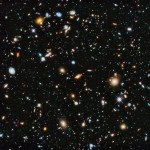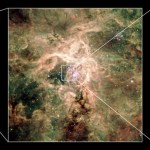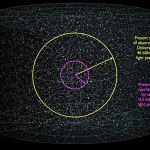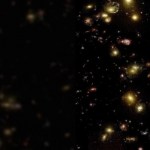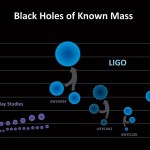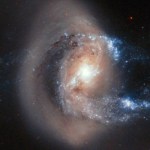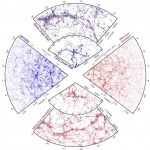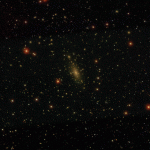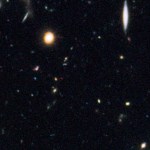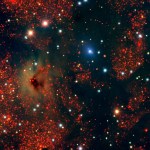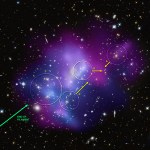Galaxies
"Truth in science, however, is never final, and what is accepted as a fact today may be modified or even discarded tomorrow. Science has been greatly successful at explaining natural processes, and this has led not only to increased understanding of the universe but also to major improvements in technology and public health and welfare." -National Academy of Sciences
It’s no secret that peering out into the distant Universe is best done from space, just as looking at our entire world is best done from that same vantage point. For all of human history until the mid-20th century, this was an…
"Suddenly whole new programs open up, things you can do that you could never do before. It'd be great scientifically, it'd be great for the nation, for educators, for students, and it'd be just great for the public at large." -Garth Illingworth
Looking farther and farther into the distant Universe is the equivalent of looking farther and farther back in time. Although Hubble has shown us galaxies from when the Universe is just 400 million years old, and satellites to measure the Cosmic Microwave Background can show us a snapshot at 380,000 years, we have no information about what’s in between…
“The more clearly we can focus our attention on the wonders and realities of the universe about us, the less taste we shall have for destruction.” -Rachel Carson
The idea that the spatial fabric of the Universe itself is expanding, and that’s what’s behind the observed relationship between redshift and distance has long been controversial, and also long-misunderstood. After all, if more distant objects appear to recede more quickly, couldn’t there be a different explanation, like an explosion that flung many things outward? As it turns out, this isn’t a mere difference in interpretation,…
"Hubble often takes images of distant gravitationally lensed galaxies to infer their substructure and to try to learn about early galaxies in general. For LUVOIR, we would have that same resolution for any galaxy! That’s truly revolutionary." -John O'Meara
If you were an observational astronomer, what would your dream telescope look like? It would have to be huge, with an incredible amount of light-gathering power. The quality of the optics would have to be pristine, and higher-precision than anything ever created before. It would have to have multispectral capabilities, extending beyond both…
“We [are] a species endowed with hope and perseverance, at least a little intelligence, substantial generosity and a palpable zest to make contact with the cosmos.” -Carl Sagan
When the Voyager and Pioneer spacecraft were launched, they contained a message emblazoned on them: a map of 14 pulsars, showing the location of Earth relative to them. This was a brilliant idea: showcase bright, unique identifiers, complete with their observed periods and distances from our world, and people would be able to find Earth. If we wanted to be found, it was the best idea 1977 had to offer.
A colorized…
"Our first priority was making sure we weren’t fooling ourselves." -Keith Riles, LIGO team member
When LIGO announced their first discovery of a black hole-black hole merger, it came as a surprise to almost everyone. The shocking part wasn’t that LIGO had seen merging black holes, but that they were discovered to be so massive. At right around ~30 solar masses each, these were black holes that were much larger than expected, forcing astronomers to confront the fact that they didn’t have a good, comprehensive model for how many black holes -- and what mass they should be -- were in the…
"This new insight may force us to rethink the whole cosmological context of how galaxies burn out early on and evolve into local elliptical-shaped galaxies. Perhaps we have been blind to the fact that early "dead" galaxies could in fact be disks, simply because we haven't been able to resolve them." -Sune Toft
How do galaxies form and grow? The theory behind it is simple and straightforward. You start with a collection of normal-and-dark matter, the normal matter collects in the center, pancakes, and forms stars over time. A little later, more gas falls in, and the galaxy continues to form…
"Space and time may have a structure as intricate as the fauna of a rich ecosystem, but on a scale far larger than the horizon of our observations." -Martin Rees
On the largest scales, dark matter has been undoubtedly the most successful theory in modern cosmology for explaining a huge variety of observations. From the motions of galaxies in clusters to the separation of mass and light when they collide, from the correlations between galactic positions to the fluctuations in the CMB, from the bending of starlight to the formation of large-scale structure, it’s clear that the Universe needs…
“There is no such thing as perpetual tranquillity of mind while we live here; because life itself is but motion, and can never be without desire, nor without fear, no more than without sense.” -Thomas Hobbes
It’s hard to believe, but despite being at rest here on the surface of Earth, we’re actually hurtling through the Universe in a variety of impressive ways. The Earth spins on its axis, giving someone at the equator a speed of some 1700 km/hr. Yet at even faster speeds, the Earth orbits the Sun, the Sun moves through the Milky Way, and there’s a great cosmic motion that applied to the…
"Not all chemicals are bad. Without chemicals such as hydrogen and oxygen, for example, there would be no way to make water, a vital ingredient in beer." -Dave Barry
When we break out the big guns -- space telescopes like Hubble or James Webb -- we can see the Universe as it was billions of years ago, if we look for long enough. From the first moment that the Universe forms stars and galaxies, so long as that light has a path to our eyes, humanity can view it with the right equipment. This record-breaking approach has brought us in contact with galaxies from as early as when the Universe was…
“No matter what technique you use, you should get the same value for the expansion rate of the universe today.” -Ben Hoscheit
When you think of the Universe on the largest scales, you likely think of galaxies grouped and clustered together in huge, massive collections, separated by enormous cosmic voids. But there’s another kind of cluster-and-void out there: a very large volume of space that has its own galaxies, clusters and voids, but is simply higher or lower in density than average.
The construction of the cosmic distance ladder involves going from our Solar System to the stars to…
“Unless one says goodbye to what one loves, and unless one travels to completely new territories, one can expect merely a long wearing away of oneself and an eventual extinction.” -Jean Dubuffet
In the far future, all the galaxies within our Local Group will merge together, with enough gas and stellar material to form trillions upon trillions of new stars. But the amount of fuel is finite, and gravitational interactions are chaotic. At some point, the star forming material contained in our galaxy will come to an end, while more and more stars and stellar remnants are ejected from the galaxy.…
“Despite its name, the big bang theory is not really a theory of a bang at all. It is really only a theory of the aftermath of a bang.” -Alan Guth
When we look to the deepest reaches of space, we can look for the “first” of any type of object. The first galaxy, the first star, the first light from the CMB, or even the first signals from the Big Bang, like gravitational waves. Yet these signals all have very different redshifts from one another, and perhaps more puzzlingly, lie at extraordinarily different cosmic distances from us.
Looking towards the north pole of the Milky Way galaxy,…
"There is always a heavy demand for fresh mediocrity. In every generation the least cultivated taste has the largest appetite." -Paul Gauguin
From our vantage point within the Milky Way, it sure does appear impressive. Hundreds of billions of stars shine in our own cosmic backyard, with our galaxy spanning a whopping 100,000 light years from end-to-end. Yet not only is that small compared to our nearest large neighbor, Andromeda, but it’s not even 20% as large as the largest spiral galaxies we find.
Severely disrupted galaxies, like NGC 6872, can extend for many times farther than a quiet…
"We’ve taken a major step back in time, beyond what we’d ever expected to be able to do with Hubble. We see GN-z11 at a time when the universe was only three percent of its current age." -Pascal Oesch
Arriving at our eyes after a journey of 13.4 billion years, the light from galaxy GN-z11 has been traveling towards us for 97% of the Universe’s present age. It’s detection and discovery, however, was a lot more complicated than simply opening up your telescope’s eyes and collecting enough light; a confluence of four separate things needed to happen all at once to make it possible.
Schematic…
"Things need not have happened to be true. Tales and adventures are the shadow truths that will endure when mere facts are dust and ashes and forgotten." -Neil Gaiman
Wherever we look in the night sky, we don't just observe the background sources of light shining our way, but also the effects of all the matter in between those distant sources and our eyes. Since all of that inbound light needs to pass through a portion of the Milky Way on its way to our eyes, it's vital that we understand how that light is distorted by our own galaxy. That means we need an understanding of the dust in our own…
"On a cosmic scale, our life is insignificant, yet this brief period when we appear in the world is the time in which all meaningful questions arise." -Paul Ricoeur
When it comes to the largest bound cosmic structures, it doesn’t get any bigger than galaxy clusters. Unless, that it, you consider when multiple galaxy clusters merge together. Located at the intersections of cosmic dark matter filaments, smaller clusters flow into the larger clusters located at such a nexus. When we get very lucky, colliding clusters can be seen.
The combination of radio and X-ray data reveal background, lensed…
"The history of astronomy is a history of receding horizons." -Edwin Hubble
As you look to greater and greater distances, you’re looking back in time in the Universe. But thanks to dark energy, what we can see and access today isn’t always going to be accessible. As galaxies grow more distant with the accelerated expansion of the Universe, they eventually recede faster than the speed of light. At present, 97% of the galaxies in the Universe aren’t reachable by us, even at the speed of light.
The observable (yellow) and reachable (magenta) portions of the Universe, which are what they are…
"It's the gravity that shapes the large scale structure of the universe, even though it is the weakest of four categories of forces." -Stephen Hawking
Galaxies don’t just exist in isolation in our Universe, but are often found bound together as a part of even grander structures. Our own Milky Way is bound in a galactic group (our local group), nearby are larger groups and galaxy clusters, and on still larger scales, cosmic superclusters appear to encompass as many as 100,000 individual galaxies.
Outlined in light blue, giant collections of galaxies can be divided up into superclusters. But…
"The problem is, you’re trying to find these really faint things, but you’re looking behind these really bright things. The brightest galaxies in the universe are in clusters, and those cluster galaxies are blocking the background galaxies we’re trying to observe." -Rachael Livermore
One of the biggest puzzles in science is exactly how the Universe became transparent to visible light. Neutral atoms -- cosmic dust -- blocks visible light, and yet before there were stars, that’s all we had. According to theory, it should be large numbers of small, faint, ultra-distant galaxies that made it…
